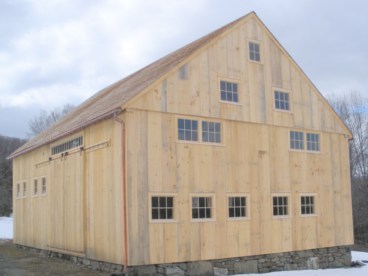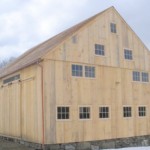Nye-Carlton Barn, Woodstock, VT
Project Overview
What began with a phone call from a fellow contractor seeking advice about a broken tie beam, turned into one of our favorite restoration projects to date. As it turned out, in addition to the broken tie beam, there was significant damage to both of the rafter plates, a second tie beam, the sill system, post feet and foundation. Although the level of damage to the barn was not uncommon, the barn itself is a rarity.
This barn has everything that we love to see. It is a scribe rule frame with stunning marriage marks, built predominantly of beech and chestnut. It is a classic English threshing barn with tapered posts and English tying joints. The timbers are all hewn with the exception of the scantlings and two sash sawn chestnut posts. Although the technique of scribing timbers continued well into the 1800’s, the abundance of hand wrought nails and the gouge marks around the peg holes (indicating the use of a nose auger), suggest that the barn was likely built in the late 1700’s. Records show that the first saw mill in the town was set up in 1785, leading us to conclude that the barn was constructed within the next twenty or so years.
The current owners of the barn had initially intended to shore the structure so that a cupola might be added. After presenting our research on the history of the barn and property, the current owners became completely invested in completing a full restoration.
When we had first surveyed the barn, we were delighted to see a marriage mark on the interior drive post and tie beam in the shape of a small ‘daisy wheel’. The daisy wheel is a circle, drawn with a compass, that usually contains six, equidistant ‘petals’. Occasionally, circles can be observed with six equidistant marks around the circumference. This type of wheel is referred to as a ‘broken spoke’. The wheel has long been used as a design tool and template for carpenters that allows for complex ratios and proportions to be used in design without carrying out long mathematical computations. Shortly after beginning work on the project, another contractor discovered a daisy wheel of about eight inches in diameter on one of the roof boards, further indicating that the wheel was likely used as a design tool for this frame. Seth was easily able to match the proportions of the frame to the wheel. Although we have seen our share of frames that fit the proportions of the daisy wheel and a number of frames with compass markings, this was the first frame that we have observed with a fully drawn wheel. The roof board with the wheel on it now hangs in the doorway of the barn.
The damage and deterioration of the frame was so wide spread, that we had to fully dismantle it to complete the restoration work. Having the frame dismantled and safely housed in our shop afforded us a great opportunity to restore every aspect of the frame under ideal conditions. We had plenty of space to lay out each wall of the frame for scribing in new material. Although there was a great deal of damage to many of the shoulders, tennons and post feet, we found that once the damaged areas were excavated, the remaining wood was of outstanding quality.
The finish work of the project was carried out by a local contractor after we had set the restored frame on its new foundation. The exterior of the frame was updated sometime during the 1860’s or 1870’s by the Carlton family. The gable and eaves walls visible to the road were covered with clapboards and trim and new sliding doors replaced the original doors that had hung from traditional strap hinges. The homeowners were able to re-use track hardware for the doors. They also opted to omit the addition of clapboards and trim in favor of vertical boarding to show off the details of the visible plate and boarding grooves. They chose shingles for the roof and added beautiful copper gutters which we thought was a really nice touch.
We felt incredibly privileged to work with such dedicated and enthusiastic homeowners to restore this frame that now stands virtually unchanged from its original configuration.

